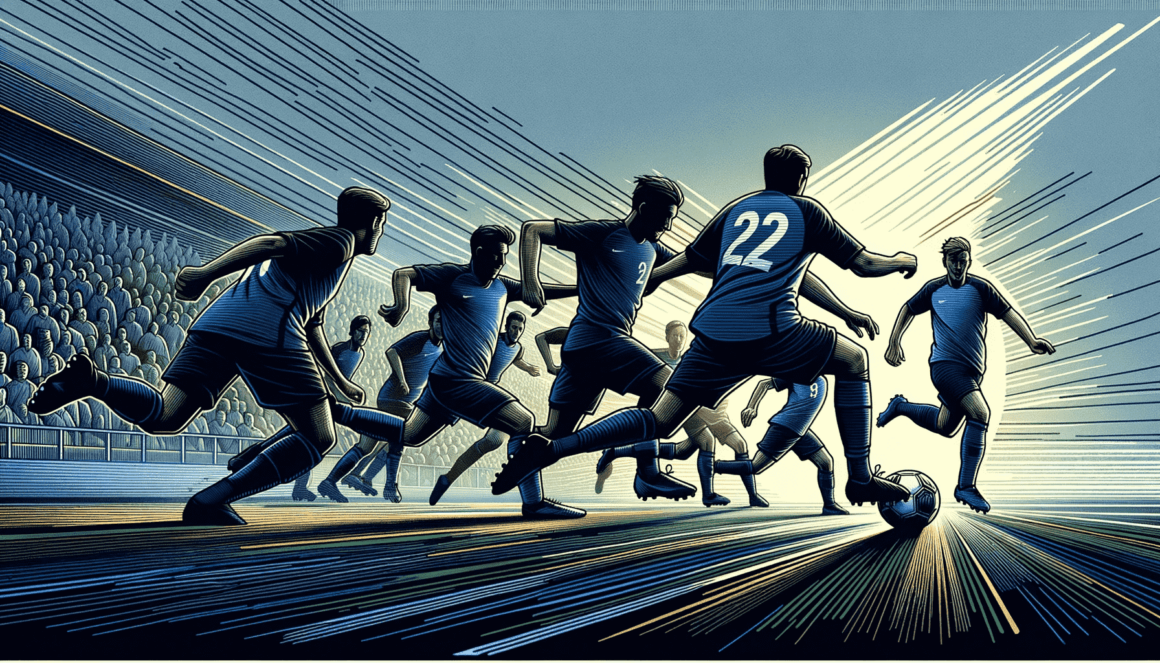Gegenpressing: A Modern Soccer Pressing Tactic
In the world of soccer, one name has become synonymous with a particular playing style. Current Liverpool manager Jürgen Klopp is known for his tactics, which made both Liverpool FC and his earlier club Borussia Dortmund complete soccer sensations.
In this article, we will explore the origins of Gegenpressing, a type of counter-attack strategy which consists in trying to win the ball immediately after your team loses it.
What Is Pressing in Soccer?

In soccer, pressing is a tactic that teams use when they want to apply pressure on the opposition to cause turnovers and win the ball back. It’s an essential game element that can, as the name implies, put the opponents under pressure and cause them to make mistakes.
There are a few different ways to press the opposition in soccer, and the most common is to have two or three players put pressure on the ball carrier while the rest of the team drops back into position.
Pressing has evolved in different ways over the years, so let’s take a look at how it developed into the popular soccer style we see in use today.
The Modern Pressing Game
Arrigo Sacchi is often credited as the innovator behind modern soccer pressing tactics. His revolutionary approach has been studied by coaches and further developed in the last couple of decades and became a prominent part of European soccer history.
Sacchi first came to fame as the coach for AC Milan in the late 80s. After winning the Italian league and the European Cup twice back to back, he led the Italian national team to the World Cup finals in 1994, where they lost to Brazil on penalty shootouts after a goalless draw in regular time and overtime.
When Sacchi first started coaching AC Milan, there were doubts about his ability to lead such an important side. One of the reasons the fans were unsure about the new manager is that Sacchi got rid of the famous catenaccio defense system and opted for an approach that was based more on the Dutch attacking soccer philosophy of Total Football.
Catenaccio was the hallmark of both AC Milan and the Italian national side. The system employed a fifth defender, called a “sweeper,” who worked behind the line of the four defending backs.
Sacchi instead used four defenders trained to press the opposition higher up on the pitch and work in a tight line catching the opposition attackers in an offside trap more often. This type of strategy simply wouldn’t work with a sweeper and defenders who sit deep on their side of the pitch.
The Evolution Of Pressing
Sacchi’s influence on Klopp’s managerial style and the development of Gegenpressing soccer tactics is no secret. Klopp admitted on one occasion that he watched a video of Arigo Sacchi’s Milan in practice a couple of hundred times! The German coach went as far as crediting Sacchi for everything that he accomplished in the game, although he never got the chance to work directly with the Italian coach.
Sacchi demonstrated that a side could press without resorting to a man-marking defense approach but rather by using positioning to close up and open space on the pitch when needed.
While Sacchi’s team used pressing as a defensive measure to get the opposition’s attack closer to the half-line as possible, Klopp’s Gegenpressing soccer method uses it on the attack to provide his teams with scoring opportunities.
Klopp learned from watching those tapes of Sacchi’s practice routines how to prepare the team for pressing tasks and how the players should cooperate as a unit on the pitch. Another revelation came to Klopp from watching Milan’s defense drills – tactics are crucial in soccer, and a weaker side can win the game if they have superior tactics!
Counter-pressing in German Football
Gegenpressing is a German word meaning “counter-pressing.” Ralf Rangnick is often credited as the godfather of German counter-pressing strategy. He was the first to start using the 4-4-2 formation and to implement Sacchi’s attacking pressing method.
He worked with his players on zonal marking and better spatial awareness rather than man-to-man marking, which had previously been the textbook approach to pressing.
Along with Sacchi’s ideas, his innovative tactics and those of Wolfgang Frank, Klopp’s mentor at FSV Meinz 05, paved the way for Klopp’s later success.
Klopp’s Approach
What makes Klopp so successful as a manager is his firm belief in the soccer tactics he uses as the ultimate means to an end. In one of his most famous quotes, he famously said:
“If you win the ball back high up the pitch and you are close to the goal, it is only one pass away (from) a really good opportunity most of the time. No playmaker in the world can be as good as a good counter-pressing situation.”
One of Klopp’s Gegenpressing strategy tenets is trying to win the ball immediately after your team loses it. If you recover possession high up in the opponent’s half, your team has a fair chance of getting a shot at goal within a few touches. The opponent’s defensive line is not organized yet, so rather than regroup, Klopp suggests that you counter-press straight away.
In pressing, Klopp doesn’t rely on Liverpool defenders but instead on the attack and midfield. Liverpool’s team creates a pressing trap, cutting off several passing options to the opponent’s defensive players.
With Salah and Mane (while he was still in Liverpool) cutting off the passing toward the two backs, Liverpool would intentionally leave a passing line toward the middle open. That’s when the Liverpool midfield springs to action and tries to regain possession.
If successful, the attackers are left in an ideal position with a lane toward the goal, between the center-backs and full-backs. They have the opportunity to go directly at goal or try and find another player – a striker or an attacking midfielder joining the attack.
Gegenpressing Formation
Counter-pressing is more about the approach to the game than it is about a specific formation.
But, there are certain unwritten rules that we can assess. For instance, the modern pressing game is more about attacking than defending.
Classical defensive tactics rely on man-on-man marking, while even with Sacchi’s AC Milan (where pressing was used in the defensive line), it was applied through zonal marking with the team that used an attacking 4-4-2 formation.
Ralf Rangnick copied the formation from AC Milan and used the 4-4-2 but with more emphasis on the team’s ability to regain possession in the opponent’s half. He would get the midfield and attack involved in the pressing game instead of using the defensive line.
Klopp most readily uses the 4-3-3 formation, as with three players in the attack, his approach of closing the passing lines and launching a counter has more chances to succeed.
Gegenpressing vs. Tiki-Taka
Klopps’ team isn’t the one that has been playing attractive soccer to the delight of the spectators in recent decades. Arsenal under Wenger has earned many fans worldwide for playing fast-paced attacking soccer.
But for the London team, it was never really about pressing and ball possession as much as opening space through rapid counter-attacks and charging from the flanks.
And then there is the F.C. Barcelona, from the years when Pep Guardiola led the team to an unprecedented string of successes. The team from Catalonia was famous for its “tiki-taka,” an attractive style of play based on an intricate passing game that the team used to maintain possession.
Guardiola popularized the “tiki-taka” during his years at Barcelona, but was later successful with a variation on this style of play in Bayern Munich in the Bundesliga and Manchester City in the English Premier League, too.
So, how do the two great managers compare when it comes to pressing tactics? Both like their teams to push high and gain possession quickly after losing it. But they do this for different tactical reasons.
Gegenpressing football tactics, as we previously explained, require the team to try and trap the pass from the opponent’s back line, looking for a fast turnover. Pep’s tactic is based much more on simply gaining possession and then organizing the attack at the team’s own pace.
An example of Liverpool’s gegenpressing approach
Pep’s high-pressing game involves a 6-second rule. The entire team is pressing high, leaving no easy option open for a pass, and giving their all for that limited period. Playing pressing is physically tasking on the players, so if they do not regain possession fast, they fall back into their positions.
While both managers have had great success with their respective sides, Pep’s tactic has relied more on having excellent players who can provide all the stamina and technical ability needed to perform their manager’s tasks.
Liverpool’s team isn’t short on world-class football talents, with Salah, Firmino, Virgil van Dijk, and many other phenomenal players. Still, Klopp’s football tactics can more easily be adapted to suit teams with less money to spend on the best players in the world.
Other Teams That Have Used Pressing Tactics Successfully
While Klopp and Sacchi before him made pressing tactics famous, other managers have also figured out how to use them to lead their teams to victory.
Teams that have made remarkable results relying on a pressing approach include Jose Mourinho’s Porto, which won the UEFA Champions League in 2004, Jupp Heynckes’s Bayern Munich, and Fabio Capello’s AC Milan.
But when it comes to the Gegenpressing soccer game that Klopp’s teams are famous for, the two most similar examples are found with two German football managers – Thomas Tuchel and Julian Nagelsmann. They used this modern game tactic to dominate numerous German clubs with their counter-attacking plays that start with the attacking players.
Thomas Tuchel took over where Klopp left in Borussia Dortmund, as the team was looking for a manager that would continue the high-pressing style that brought Borussia to the UEFA Champions League finals.
Julian Nagelsmann is a young German football expert who often uses counter-press tactics as the head coach of Bayern Munich. His team secured the Bundesliga season 2021/2022 league title three rounds before the end of the season. The young manager is known for using a variety of formations and counter-press tactics.
Bottom Line
Liverpool’s soccer style has captured the imagination of soccer fans around the world. Their flashy, attractive high-scoring game can be credited to the German expert on the bench.
Jürgen Klopp made his name with Borussia Dortmund, where he favored a specific type of counter-attack game. He brought this successful Gegenpressing football strategy to Anfield Road, where he continues to make football history.
FAQ
Who invented Gegenpressing?
The term was first coined by Ralf Rangnick, who started to use the counter-press tactic based on zonal pressing rather than man-marking. However, the term became internationally used only after Jürgen Klopp’s managerial success with Borussia Dortmund.
Which teams use Gegenpressing?
Teams with a tradition of using this tactic include Liverpool, Borussia Dortmund, RB Leipzig, and Bayern Munich. PSG, with Thomas Tuchel as manager, also used this tactical approach.
Does Pep Guardiola use Gegenpressing?
Guardiola’s Manchester City uses a pressing tactic that isn’t the same as the gegenpressing that some other teams deploy.
Guardiola’s tactic is more centered on keeping possession for long periods and organizing attacks from the back of the midfield line rather than opening fast counter-attacks through offensive pressure on the opposing team’s defenders.
 BC.Game
BC.Game  BitStarz
BitStarz  Ducky Luck
Ducky Luck  Red Dog Casino
Red Dog Casino